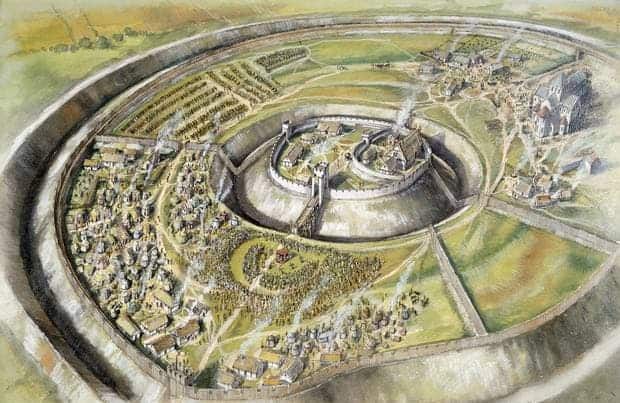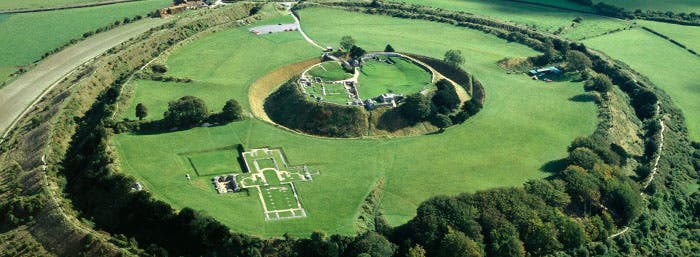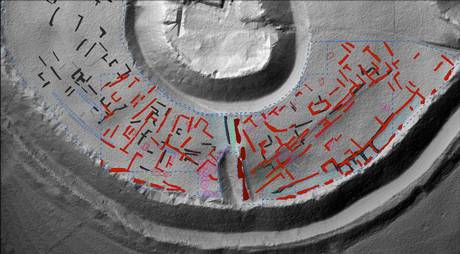It’s one of England’s better kept secrets – Old Sarum is a hidden gem among gems, one of the most spectacular ancient sites in Europe and in the world. Old Sarum is the site of the earliest settlement of Salisbury in England. The site contains evidence of human habitation as early as 3000 BC, but only now have archaeologists uncovered the network of buildings in the city, including a very large and imposing castle.

Using top notch geophysical techniques, a research team of students and academics from the University of Southampton carried out a survey on the site, scanning the underground and detecting buried structures. They located numerous structures on the inside and outside of the fortification, but what they found in the center is absolutely stunning: a 170m long, 65m wide palace complex, which has walls 3m thick and is arranged around a large courtyard, surrounded by many significant houses. Basically, this finding shows archaeologists and historians where major political and religious centre was in Norman Britain. The investigations revealed a settlement including structures from the late 11th century, contemporary with the construction of a cathedral and castle. The city was inhabited for over 300 years, but then abandoned, as the people moved to New Sarum (today’s Salisbury).
Professor David Bates of the University of East Anglia, a leading authority on Norman England said that this discovery is of enormous importance:
“It reveals the monumental scale of building work taking place in the earlier 12th century,” he said.

Indeed, because the city was inhabited for only three hundred years and then abandoned, the site is pristine; there is no “contamination” – later structures built on top of the older ones. Also, the city was a major one, so it has all the buildings and structures you would hope to find in a city from that period. Among the findings, archaeologists report:
- The major castle, the biggest “unknown” castle in the UK
- A series of massive structures along the southern edge of the outer bailey defensive wall, probably defensive structures
- An open area of ground behind these large structures, perhaps used to muster troops for these structures
- Several large residential areas
- Evidence of deposits indicating industrial features, such as kilns or furnaces
- Evidence of rock quarrying.
Basically, they put up an entire plan of the city. Kristian Strutt of the University of Southampton, the archaeologist leading the geophysical survey, added:
“Archaeologists and historians have known for centuries that there was a medieval city at Old Sarum, but until now there has been no proper plan of the site. Our survey shows where individual buildings are located – and from this we can piece together a detailed picture of the urban plan within the city walls.”
The research was conducted as part of the Old Sarum and Stratford-Sub-Castle Archaeological Survey Project, directed by Kristian Strutt and fellow Southampton archaeologists Timothy Sly and Dominic Barker. In order to conduct the geophysical underground mapping, they conducted magnetic, electrical and ground penetrating radar (GPR) measurements. These are all non-invasive techniques, and allow archaeologists to know what they’re dealing with without actually seeing it.

The Old Sarum site is under the custodianship of English Heritage, who allowed them to conduct the researchHeather Sebire, Property Curator at English Heritage, comments:
“Having the team of archaeologists on site over the summer gave our visitors a chance to find out more about how important historic landscapes are surveyed. The use of modern, non-invasive surveying is a great start to further research at Old Sarum. From this work we can surmise much about the site’s past and, whilst we can’t conclusively date the findings, it adds a new layer to Old Sarum’s story. We welcome the chance to find out more about our sites, and look forward to exploring ideas for further research in the future.”
Old Sarum was originally an Iron Age fort established around 400 BC and occupied by the Romans after the conquest of Britain in AD 43. The city continued to grow and thrive, and in 1092, a cathedral was already constructed. Archaeologists hope to return again in 2015 and conduct even more detailed measurements. In the meantime, they will have to evaluate and analyze their current results, which paint an extremely detailed picture of ancient British society.


